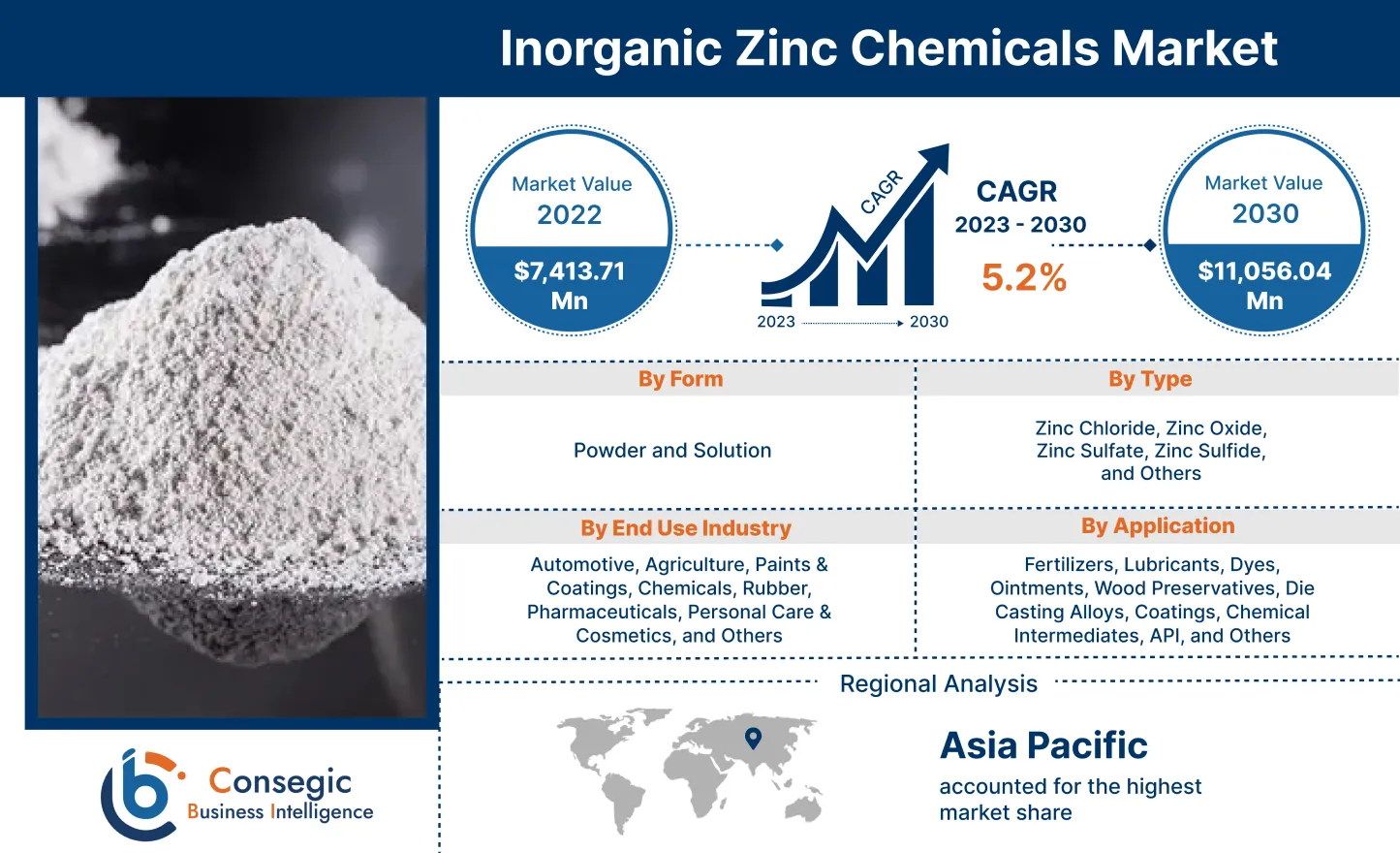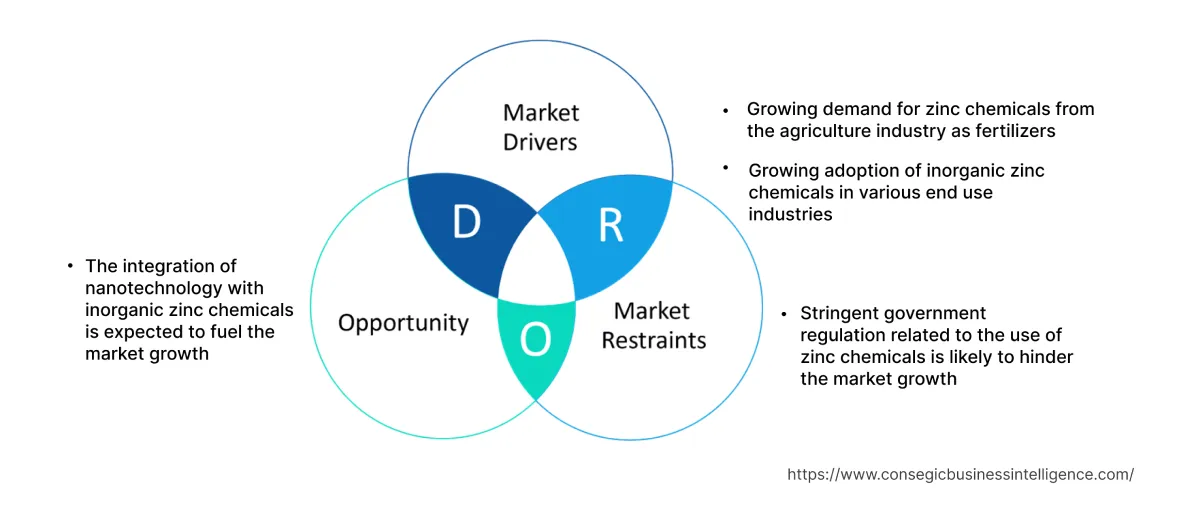- Summary
- Table Of Content
- Methodology
Inorganic Zinc Chemicals Market Size :
Consegic Business Intelligence analyzes that the inorganic zinc chemicals market size is growing with a CAGR of 5.2% during the forecast period (2023-2030), and the market is projected to be valued at USD 11,056.04 Million by 2030 from USD 7,413.71 Million in 2022.
Inorganic Zinc Chemicals Market Scope & Overview:
Inorganic zinc chemicals refer to a group of compounds that contain zinc as the primary element and are derived from inorganic sources. The chemical has the atomic number 30 and the symbol Zn. The element is a blue-white metal which is classified as a transition element that consists of properties namely hardness, ductility, and moderate strength. Some of the common types of inorganic zinc chemicals are Zinc sulphide, zinc oxide, and zinc chloride. Such types of chemicals are used in a variety of industrial applications including rubber tires, ceramics, glass, and animal feed.
In the agriculture industry, inorganic zinc chemicals are used for supplementation purposes. In the pharmaceutical industry, Zn chemicals are deployed as Active Pharmaceutical Ingredients (API) in skin care medicinal creams. Further, inorganic zinc chemicals are also used in the chemical industry as an intermediate for the production of other industrial chemicals.
Inorganic Zinc Chemicals Market Insights :
Key Drivers :
Growing demand for zinc chemicals from the agriculture industry as fertilizers
Inorganic zinc chemicals is widely deployed in the agriculture industry as a fertilizer to enhance crop productivity and soil health. Zinc Oxide is recognized as an essential micronutrient to grains and plants. The use of zinc oxide as an inorganic micronutrient fertilizer includes direct application to soils to correct zinc deficiency, root dipping, and seed coating. In addition, technological advancements in the agricultural industry such as biotechnology and genetic engineering have also led to increased crop production that contributes to the growth of the market. Inorganic zinc chemicals will continue to be used in agriculture to sustain crop yields to meet the demand for food in a growing population, which help to boost the demand for the inorganic zinc chemicals market.
Growing adoption of inorganic zinc chemicals in various end use industries
Zinc chemicals are widely used by various end-use industries as activators, bulking agents, and chemical intermediates, among others. In the rubber industry, zinc chloride is utilized as an activator for the vulcanization of rubber for enhanced durability. The rising demand for rubber from the automotive industry for applications including tires is accelerating the growth of the inorganic zinc chemicals market. In addition, in organic zinc chemicals are used as a catalyst and in the production of a variety of products such as paints, coatings, and dyes. Hence, the rising demand for zinc chemicals from various end-use industries proliferates market growth.
Key Restraints :
Stringent government regulation related to the use of zinc chemicals is likely to hinder the market growth
The stringent regulation imposed by the government on the use of zinc chemicals is likely to hamper the market growth. For instance, regulatory bodies such as Occupational Safety and Health Administration (OSHA) and Public Employees Occupational Safety and Health (PEOSH) have included zinc in the list of hazardous substances. Zinc could cause dermatitis and also harm the male reproductive system due to prolonged exposure. Hence, the stringent government regulations are anticipated to serve as the major restraining factor for the inorganic zinc chemicals market
Future Opportunities :
The integration of nanotechnology with inorganic zinc chemicals is expected to fuel the market growth
The advancement in nanomaterial technology has led to the increased use of inorganic zinc chemicals including zinc oxide nanoparticles. For instance, according to the National Library of Medicine, zinc oxide has a wide scope of applications in drug delivery systems, nano-medicine, biotechnology, food, and among others owing to its antimicrobial characteristics. Therefore, the introduction of nanotechnology in zinc chemicals is expected to offer lucrative opportunities to the key players operating in the inorganic zinc market.
Inorganic Zinc Chemicals Market Report Insights :
| Report Attributes | Report Details |
| Study Timeline | 2017-2030 |
| Market Size in 2030 | USD 11,056.04 Million |
| CAGR (2023-2030) | 5.2% |
| By Form | Powder and Solution |
| By Type | Zinc Chloride, Zinc Oxide, Zinc Sulfate, Zinc Sulfide, and Others |
| By Application | Fertilizers, Lubricants, Dyes, Ointments, Wood Preservatives, Die Casting Alloys, Coatings, Chemical Intermediates, API, and Others |
| By End Use Industry | Automotive, Agriculture, Paints & Coatings, Chemicals, Rubber, Pharmaceuticals, Personal Care & Cosmetics, and Others |
| By Region | North America, Europe, Asia-Pacific, Latin America, and Middle East & Africa |
| Key Players | EverZinc, TIB Chemicals AG, Weifang Longda Zinc Industry Co. Ltd, Rubamin, ZINC OXIDE LLC, Hakusuitech Co. Ltd., Merck KGaA, Tata Chemicals Ltd., TOHO ZINC CO., LTD., Zinc Nacional S.A., ARIHANT SOLVENTS AND CHEMICALS |
Inorganic Zinc Chemicals Market Segmental Analysis :
By Form :
The form segment is categorized into powder and solution. In 2022, the powder segment held the highest share in the inorganic zinc chemicals market. The capability of powder based inorganic zinc chemicals is used to improve the functioning of more than 300 hormones and enzymes in animals. The increasing application of inorganic zinc for delivering important micronutrients to the animal feed industry is accelerating market growth. Moreover, the growing adoption of powdered zinc oxide in personal care & cosmetic products owing to the properties such as mild antiseptic effects, and UV absorption is driving the segment growth.
Moreover, the liquid segment is anticipated to register the fastest CAGR over the forecast period. Liquid inorganic zinc chemicals are extensively used in the paint, rubber, and plywood industries due to their high purity and excellent chemical composition. For instance, ARIHANT SOLVENTS AND CHEMICALS, headquartered in India, offers high-purity liquid zinc oxide that is used as an additive in the rubber and paint industry. Therefore, the above-mentioned factors are expected to propel the liquid segment.
By Type :
The type segment is classified as zinc chloride, zinc oxide, zinc sulfate, zinc sulfide, and others. The zinc oxide segment held the highest share of 33.50% in the inorganic zinc chemicals market. The extensive use of zinc oxide (ZnO) as an additive in numerous products and materials including rubber, ceramics, and glass owing to the high heat capacity and conductivity is accelerating the market growth. In addition, the ability of zinc oxide to soothe skin and ease irritation is proliferating the demand for ZnO in the personal care & cosmetics segment. For instance, EverZinc, a manufacturer of zinc chemicals, offers Zano powders for skincare that delivers distinct UVA/UVB protection enabling SPF values up to 50+. Therefore, the above-mentioned factors are driving the market growth.
However, the zinc chloride segment is expected to register the fastest CAGR over the forecast period. The wide scope of application of zinc chloride as a corrosion inhibitor for cooling water treatment in various water facilities. In addition, the deployment of zinc chloride in water treatment industries to remove high concentrations of metals and acids is also anticipated to drive market growth.
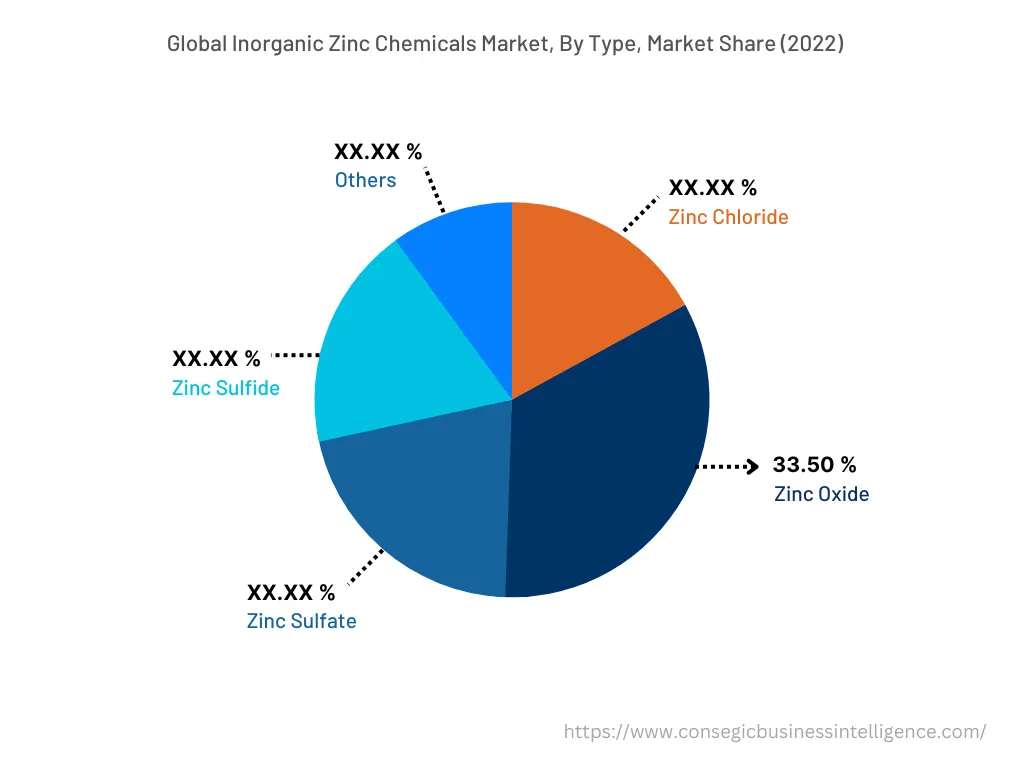
By Application :
The application segment is categorized into fertilizers, lubricants, dyes, ointments, wood preservatives, die casting alloys, coatings, chemical intermediates, API, and others. In 2022, the fertilizers segment held the highest share of the market. Inorganic zinc chemicals such as zinc sulfide and zinc oxide are widely deployed as additives for the production of fertilizers. The growing zinc deficiency that could lead to the loss of crop production and quality is accelerating the demand for inorganic zinc chemicals. For instance, as per the CABI (Centre for Agriculture and Bioscience International), crop yields of about 40% are lost to pests, climate damage, and insufficient nutrients. In addition, the rising advancements in the agricultural industry is another influencing factor that is driving the growth of the fertilizers segment.
However, the chemical intermediates segment is expected to witness the fastest CAGR in the inorganic zinc chemicals market during the forecast period. Inorganic zinc chemicals are used as chemical intermediates for the production of various products including paints & coatings, dyes, and lubricants. The growing demand zinc chemical-based products in various end-use industries such as building & construction and automotive is expected to create lucrative opportunities for the inorganic zinc chemicals market over the forecast period.
By End Use Industry :
Based on end use industry, the market is divided into automotive, agriculture, paints & coatings, chemicals, rubber, pharmaceuticals, personal care & cosmetics, and others. In 2022, the agriculture segment accounted for the largest market share in the inorganic zinc chemical market. Zinc chemicals are widely used in organic farming practices including precision agriculture owing to their ability to enhance soil fertility. Moreover, the rising demand for sustainable agricultural practices is contributing significantly is increasing the demand for inorganic zinc chemicals that, in turn, promote market growth.
However, the chemicals segment is expected to witness the fastest CAGR during the forecast period in the market. The growth of the market is attributed to the ability of inorganic zinc chemicals to offer resistance against corrosion along with exhibiting catalytic properties. Additionally, the wide scope of applications including paints & coatings, dyes, lubricants, and wood preservatives, among others is also expected to fuel the market growth over the forecast period.
By Region :
The regional segment includes North America, Europe, Asia Pacific, Middle East and Africa, and Latin America.
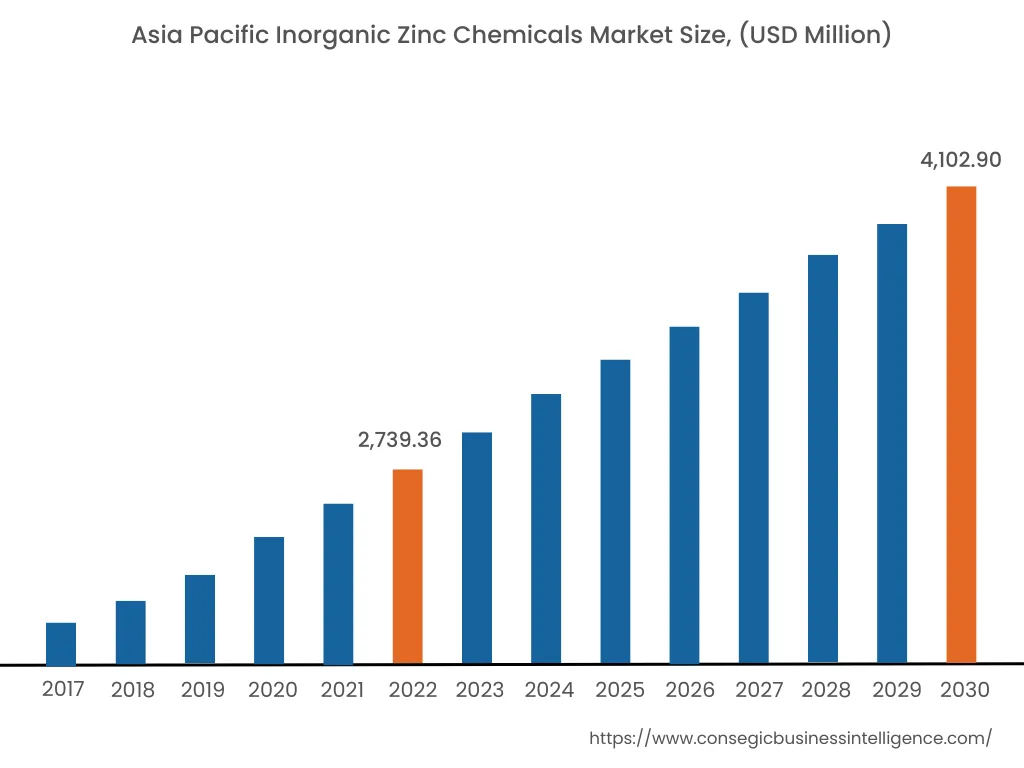
In 2022, Asia Pacific accounted for the highest market share at 36.95% and was valued at USD 2,739.36 million, and is expected to reach USD 4,102.90 million in 2030. In Asia Pacific, China accounted for the highest market share of 38.05% during the base year of 2022. The rising demand for rubber goods from various end use industries such as automotive, and consumer goods are propelling the market growth in the region. Additionally, the growing agricultural practices in the region is accelerating the demand for inorganic zinc chemicals as fertilizers.
However, North America is expected to register the fastest CAGR of 6.1% in the market during the forecast period. The increasing demand for clean and safe water particularly in U.S. and Canada is expected to drive the demand for inorganic zinc chemicals. Moreover, inorganic zinc chemicals are used in the production of other industrial chemicals such as zinc borate, zinc octoate, and zinc stearate that are used in paints & coatings, and dyes. Thus, the growing chemical industry in the region is expected to drive the inorganic zinc chemicals market growth.
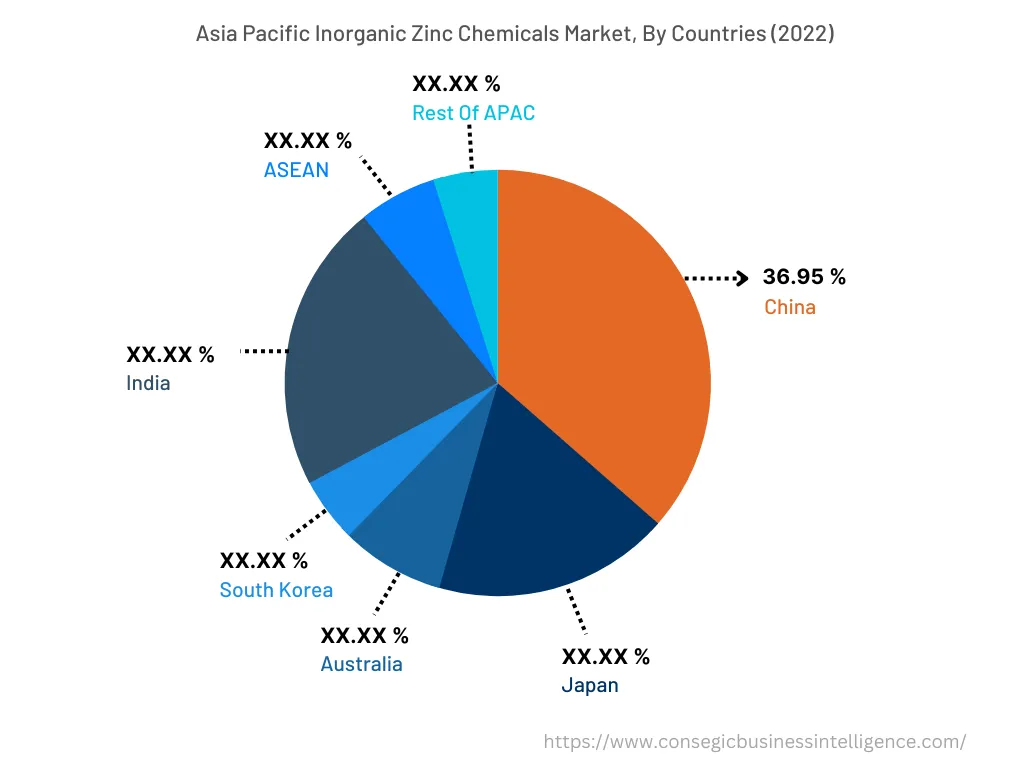
Top Key Players & Market Share Insights:
The inorganic zinc chemicals market is highly competitive, with several large players and numerous small and medium-sized enterprises. These companies have strong research and development capabilities and a strong presence in the market through their extensive product portfolios and distribution networks. The market is characterized by intense competition, with companies focusing on expanding their product offerings and increasing their market share through mergers, acquisitions, and partnerships. The key players in the market include -
- Weifang Longda Zinc Industry Co. Ltd
- Rubamin
- ZINC OXIDE LLC
- Hakusuitech Co. Ltd.
- Merck KGaA
- Tata Chemicals Ltd.
- EverZinc
- TIB Chemicals AG
- TOHO ZINC CO., LTD.
- Zinc Nacional S.A.
- ARIHANT SOLVENTS AND CHEMICALS
Recent Industry Developments :
- In June 2022, EverZinc combined with U.S. Zinc, a manufacturer of zinc chemicals, and Aterian Investment Partners (“Aterian”), a private investment firm to form the prominent global zinc chemistry business.
Key Questions Answered in the Report
What was the market size of the inorganic zinc chemicals industry in 2022? +
In 2022, the market size of inorganic zinc chemicals was USD 7,413.71 million
What will be the potential market valuation for the inorganic zinc chemicals industry by 2030? +
In 2030, the market size of inorganic zinc chemicals will be expected to reach USD 11,056.04 million.
What are the key factors driving the growth of the inorganic zinc chemicals market? +
Growing demand for zinc chemicals from the agriculture industry as fertilizers is the key factor driving the growth of the inorganic zinc chemicals market.
What is the dominating segment in the inorganic zinc chemicals market by type? +
In 2022, the zinc oxide segment accounted for the highest market share of 33.50% in the overall inorganic zinc chemicals market.
Based on current market trends and future predictions, which geographical region will have the fastest impact on the Inorganic Zinc Chemicals market's growth in the coming years? +
North America is expected to be the fastest-growing region in the market during the forecast period.
